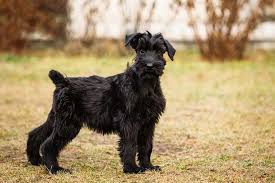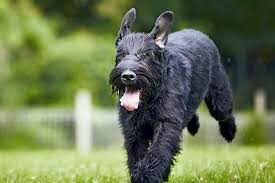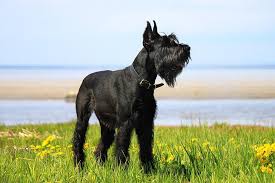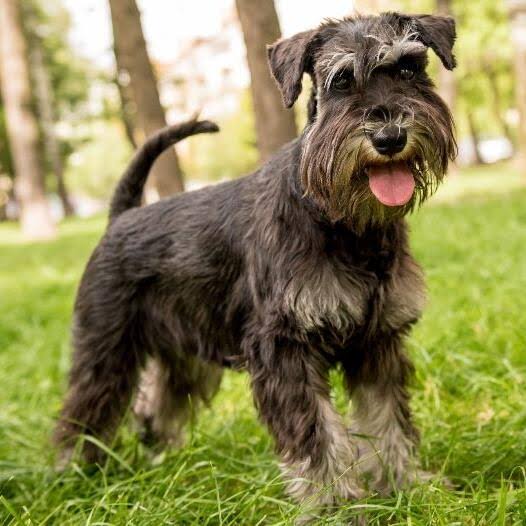The Giant Schnauzer is a large-sized dog breed that belongs to the Working Group according to the American Kennel Club (AKC) classification. The Giant Schnauzer is a robust, powerful, and athletic dog with a distinctive appearance. They have a square-shaped body, a sturdy build, and a thick, wiry double coat that comes in solid black or salt and pepper coloration. They have a distinctive “beard” and “eyebrows” that give them a unique and expressive look.
Adult male Giant Schnauzers typically stand between 25.5 to 27.5 inches (65 to 70 cm) at the shoulder, and adult females are slightly smaller, measuring between 23.5 to 25.5 inches (60 to 65 cm). They typically weigh between 60 to 85 pounds (27 to 39 kg).
Giant Schnauzers are known for their intelligence, confidence, and protective nature. They are loyal and affectionate towards their families, but can be wary of strangers, making them excellent watchdogs. They require early socialization and training to develop good manners and become well-behaved pets. They have a high energy level and require regular exercise and mental stimulation to thrive.
Read Also: Proper Guide and Principles of Rodent Control
History and Origin of the Giant Schnauzer Dogs

The Giant Schnauzer is a majestic and powerful breed of dog that has a rich history dating back to the 19th century. This breed originated in Germany and has since become a popular choice for working and guarding roles, as well as a loyal and loving companion for many families around the world. In this article, we will explore the fascinating history and origin of the Giant Schnauzer, from its early beginnings to its modern-day status as a beloved and versatile breed.
The exact origins of the Giant Schnauzer are somewhat unclear, as there are several theories about its ancestry. However, it is believed that the breed emerged in the Bavarian Alps region of Germany in the mid- to late-1800s. The breed was developed by crossing smaller Schnauzer breeds with larger working breeds such as the Great Dane, Boxer, and Bouvier des Flandres to create a larger and more robust working dog.
The Giant Schnauzer was initially bred to work as a versatile farm dog, performing a wide range of tasks, including herding livestock, guarding the farm, and driving carts. They were also known for their ability to protect their owners and their property from intruders, making them invaluable as guard dogs. The breed’s intelligence, endurance, and versatility quickly gained popularity among farmers and merchants in the region.
The Giant Schnauzer gained recognition as a distinct breed in Germany in the early 20th century. The first Giant Schnauzer club, the Schnauzer-Klub von 1913, was established in Munich in 1913, and the breed’s first standard was developed in 1923. The standard defined the breed’s physical characteristics and temperament, including its distinctive appearance, size, and working abilities.
The breed’s popularity continued to grow in Germany, and Giant Schnauzers were used during World War I as messenger dogs, search and rescue dogs, and even as police and military dogs. After the war, many soldiers brought Giant Schnauzers back to their homes, further spreading the breed’s popularity across Europe.
In the 1920s, the breed was also introduced to the United States, where it quickly gained recognition among dog enthusiasts. The American Kennel Club (AKC) officially recognized the Giant Schnauzer in 1930, and the breed was classified as a member of the Working Group. Today, the Giant Schnauzer is recognized by major kennel clubs around the world, including the AKC, the United Kennel Club (UKC), and the Fédération Cynologique Internationale (FCI).
Throughout history, the Giant Schnauzer has been known for its exceptional working abilities. The breed was initially bred to be a versatile farm dog, assisting with various tasks such as herding, guarding, and cart pulling. As the breed’s popularity spread, it also gained recognition for its abilities as a police, military, and search and rescue dog.
Giant Schnauzers are known for their intelligence, courage, and loyalty, making them well-suited for working roles that require problem-solving skills, fearlessness, and dedication. They have a strong protective instinct and are known for their ability to assess and respond to different situations. Their large size, strength, and stamina make them well-suited for physically demanding tasks, and their keen sense of smell and hearing make them excellent search and detection dogs.
In addition to their working roles, Giant Schnauzers are also valued as guard dogs. They are known for their alertness, territorial nature, and protective instincts, making them excellent watchdogs. They are known to be wary of strangers and will bark to alert their owners.
Health Issues and Lifespan of the Giant Schnauzer Dog Breed

One common health issue in Giant Schnauzers is hip dysplasia, which is a genetic condition that affects the hip joint and can cause pain and discomfort. Regular exercise, maintaining a healthy weight, and providing joint supplements as recommended by a veterinarian can help manage hip dysplasia in Giant Schnauzers.
Another health concern for Giant Schnauzers is bloat, also known as gastric torsion or twisted stomach. This is a life-threatening condition where the stomach fills with gas and twists upon itself, cutting off blood supply to the organs. Bloat can cause rapid deterioration and requires immediate emergency medical attention. Feeding multiple small meals throughout the day, avoiding strenuous exercise before and after meals, and using elevated food and water bowls can help reduce the risk of bloat in Giant Schnauzers.
Giant Schnauzers may also be prone to certain eye conditions, such as progressive retinal atrophy (PRA) and cataracts. PRA is a degenerative eye disease that can lead to blindness, while cataracts are a clouding of the eye’s lens that can also cause vision impairment. Regular eye examinations by a veterinary ophthalmologist can help detect and manage these conditions early.
Like many large breeds, Giant Schnauzers may also be prone to certain joint issues, such as arthritis and cruciate ligament tears. Providing regular exercise, maintaining a healthy weight, and providing joint supplements or medications as recommended by a veterinarian can help manage joint health in Giant Schnauzers.
It’s important to note that responsible breeding practices, regular veterinary care, and a healthy lifestyle can help reduce the risk of these health issues in Giant Schnauzers. If you are considering getting a Giant Schnauzer, it’s essential to find a reputable breeder who tests their breeding dogs for common health issues and follows responsible breeding practices.
Regular veterinary care, including vaccinations, dental care, and routine check-ups, is also important for maintaining the overall health and well-being of a Giant Schnauzer. Keeping up with a balanced diet, regular exercise, and providing mental stimulation can also contribute to a healthy lifestyle for this breed.
Additionally, while the Giant Schnauzer is generally a healthy breed, they may be prone to certain health issues like hip dysplasia, bloat, and eye conditions. Responsible breeding practices, regular veterinary care, and a healthy lifestyle can help manage and reduce the risk of these health issues, ensuring that your Giant Schnauzer lives a long, happy, and healthy life.
If you are considering getting a Giant Schnauzer or any other breed, it’s always best to consult with a veterinarian and do thorough research to understand the breed’s health needs and potential health risks. Remember, prevention and proactive care are key to keeping your furry friend in the best possible health.
Complete Grooming and Care Guide of the Giant Schnauzer Dog

Coat Care: The Giant Schnauzer has a wiry and dense double coat that requires regular grooming to prevent matting and keep it in good condition. They should be brushed at least once or twice a week to remove loose hair and prevent tangles. A slicker brush or a comb with wide teeth can be used for this purpose. Regular brushing also helps to distribute the natural oils in the coat, keeping it healthy and shiny.
Trimming: Giant Schnauzers require regular trimming of their coat to maintain their desired look. Their coat should be trimmed evenly all over the body to a length of about 1 inch, with the hair on the legs slightly longer than the body. Trimming the hair around the ears, paws, and tail is also important to keep them tidy and prevent matting.
Stripping: Giant Schnauzers have a coat that can be stripped, which involves removing dead hairs by hand or with a stripping knife to promote healthy coat growth. Stripping should be done by a professional groomer or a knowledgeable owner who is familiar with the technique.
Bathing: Giant Schnauzers should be bathed regularly, usually every 4 to 6 weeks, or as needed depending on their activity level and lifestyle. Use a mild dog shampoo and warm water, and be sure to rinse thoroughly to remove all shampoo residue. It’s important to keep the ears clean and dry during and after bathing to prevent ear infections.
Nail Care: Giant Schnauzers have thick and strong nails that grow continuously and may require regular trimming. Long nails can cause discomfort and may even cause gait issues. Trim the nails regularly using a sharp pair of dog nail clippers, being careful not to cut the quick, which is the blood vessel inside the nail. If you are not confident in trimming the nails, it’s best to seek professional help from a groomer or a veterinarian.
Dental Care: Good dental hygiene is essential for the overall health of your Giant Schnauzer. Brush their teeth regularly with a dog-specific toothpaste and toothbrush to prevent tartar buildup, gum disease, and bad breath. Providing dental chews or toys can also help keep their teeth clean and healthy.
Exercise: Giant Schnauzers are an active breed and require regular exercise to keep them physically and mentally stimulated. Daily walks, runs, or other forms of exercise, such as playing fetch or agility, are important to keep them mentally and physically fit. Lack of exercise can lead to behavioral issues and obesity, so make sure to provide ample opportunities for physical activity.
Nutrition: Providing a balanced and nutritious diet is crucial for the health and well-being of your Giant Schnauzer. Feed them a high-quality dog food that meets their specific age, size, and activity level requirements. Avoid feeding table scraps or human food, as it can cause digestive issues and weight gain. Consult with your veterinarian for dietary recommendations and feeding schedule.
Regular Vet Visits: Regular veterinary care is essential for the health of your Giant Schnauzer. Schedule regular check-ups with your veterinarian for vaccinations, preventive care, and early detection of any health issues. It’s important to stay up-to-date with vaccinations, flea and tick prevention, and heartworm prevention, as recommended by your veterinarian.
Mental Stimulation: Giant Schnauzers are intelligent and active dogs that require mental stimulation as well. Provide them with toys, puzzles, and other enrichment activities to keep their minds engaged and prevent boredom. Training sessions, obedience classes, and interactive playtime with their owner are also very vital.
Read Also: Integrated Pest Management (IPM) in the Control of Storage Insects
Mini Schnauzer

The Miniature Schnauzer is a German breed that was developed in the late 19th century. They were originally bred as small-sized working dogs on farms to help control rodents, such as rats and mice.
The Miniature Schnauzer is a small dog with a sturdy and square-built body. They have a distinctive appearance with a dense, wiry double coat that comes in various color combinations, including salt and pepper, black, and black and silver.
They have a distinctive beard, bushy eyebrows, and a prominent mustache, which gives them a distinctive and unique look. The Miniature Schnauzer’s ears are usually cropped to stand upright, but they can also be left natural.
The Miniature Schnauzer is known for their friendly and outgoing personality. They are intelligent, alert, and eager to please, which makes them highly trainable. They are also known for their loyalty and affection towards their owners, and they make great companions and family pets.
Miniature Schnauzers are known to have a bold and assertive nature, which can sometimes make them wary of strangers and other animals. Proper socialization and early training are important to ensure that they develop into well-behaved and well-adjusted dogs.
Read Also: Top 5 Fashion Brands For You
